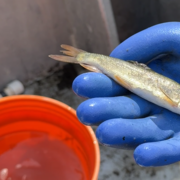Habitat Use and Evaluation
Population Dynamics
Threatened and Endangered Species
Klamath Falls Field Station (KFFS)
The Klamath Falls Field Station (KFFS) conducts research on rare and imperiled fishes in the Klamath Basin and the desert southwest. Staff at KFFS research life history, population dynamics, and ecological and anthropogenic stressors on fishes in lentic and lotic habitats. Research at the KFFS helps managers make informed decisions about resource use in sensitive and complex arid ecosystems.






